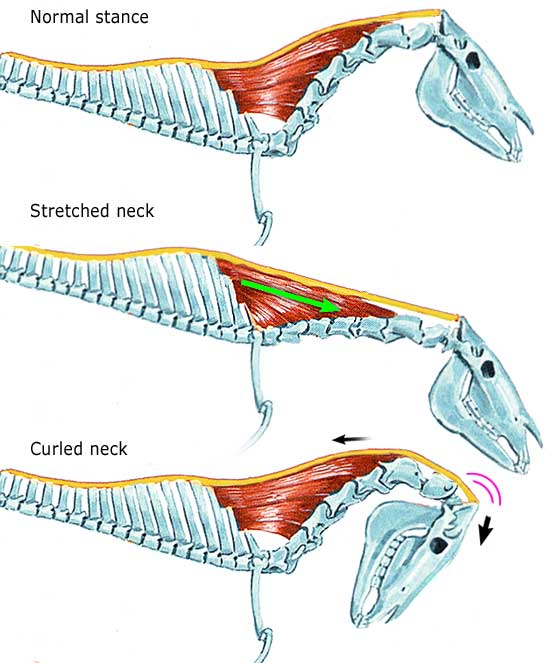
The equine neck and its function during locomotion (2)
The article about The equine neck and its function during locomotion (1) continues in this summary article
3. Elastic structures
Ligaments are known for storage of elastic energy, however there are still questions about how the lig. nuchae is contributing to the locomotor efficiency of the horse. Recently knowledge on fasciae seems to be expanding. The quality of this tissue varies between individuals. Its viscoelastic properties are reduced under stress and by disease and may be a reason for reduced gait efficiency in those conditions. In humans, the thoracolumbar fascia creates an extensor moment. We may assume a similar effect of the equine cervical fascia, which makes it work together with the prominent lig. nuchae.
In maximum head/neck flexion, the lig. nuchae stretches inequally in its different parts. In this posture the lig. nuchae is not working as a unit, suggesting limitations on the cycling of energy. In maxium flexion the lig. nuchae is stretched over the cranial vertebrae against the neck, thus exerting forces directed vertically onto the first, second and third cervical vertebrae
4. Segmental movement of the neck vertebrae
A recent study found that the equine cervical vertebral column range of motion was the stiffest in extension, thus reducing the need for extensor muscle activity, as passive structures counteract the gravitational forces acting on the neck.
The space where the spinal nerve passes through the intervertebral foramen of the cervical vertebrae is reduced during extension. Pressure on the nerve roots from the 4th cervical vertebra to the first thoracic vertebra has the potential to temporarily reduce nerve function. This supports the finding of reduced nerve function in the head/neck position with the nose behind the vertical, the cranial neck flexed and the caudal neck in extension.
> Zsoldos et al., Zoology (2015). All rights reserved to 2015 Elsevier GmbH. Click here for the Pubmed summary


